Unleashing creativity within constraints.
In the realm of 3D form creation, the engineer, architect, and sculptor each wield their unique skills and knowledge, drawing inspiration from historical precedents. However, it is within the realm of structural engineering that the greatest constraints and the least unbridled freedoms lie. The structural engineer shoulders the weight of codes and regulations, necessarily ensuring life safety and compliance. Yet, it is precisely within these constraints that the engineer’s ability to create groundbreaking designs emerges. Polytechnic training, coupled with aesthetic sensitivity, is the domain of the new structural engineer of the 21st century.
Renowned engineer Peter Rice, in his autobiographical work “An Engineer Imagines,” emphasized the engineer’s essential role in realizing design ideas that can only be brought to life through their creator’s technical expertise. Rice recognized that aesthetics, as well as engineering mechanics, are intertwined in the process of form-finding. This notion echoes the philosophy of Eduardo Torroja, founder of the International Association for Shell and Spatial Structures (IASS), who believed that rationality and imagination must converge in the design process for optimal results. Torroja meticulously shaped each part of a structure to enhance both its appearance and efficiency. He believed that the creation of truly beautiful structures required an engineer to have a serene and acute artistic sensibility, a fecund creative imagination, and the technical skill to comprehend the behavior of structures.
A Call to Action
Today, the structural engineering profession finds itself at a critical juncture, in need of a revival and a reaffirmation of its role as a form finder, i.e., creating “spatial structures” and consequently designing “special structures.” In the late 20th century, too much creative control was ceded to the architect, and in the early 21st century, the specter of design by Artificial Intelligence looms large. A “Call to Action” is proposed here, which reinvents a venerable form-finding tradition guided by the engineer’s unique skill set. This tradition flourishes when form-finding is guided by “Discipline and Play.” Just as a game without rules descends into chaos, a lack of playfulness stifles innovation. Regrettably, engineers have often succumbed to a formulaic and robotic mindset, eroding the vitality of our profession. To overcome this challenge, it is imperative to reimagine and reinvent 19th-century geometric analysis and design tools for the 21st century. At California Polytechnic State University and in a new startup company, Poly Shells LLC, a new set of geometric tools has been created to analyze and design efficient and elegant thin shell structures.
While architects are trained to be form finders and spend years honing their design skills, they often do so completely apart from any guidance from engineering faculty in most universities. The master engineers possess a unique set of technical tools and knowledge that allows for the creation of form in a distinctive and impactful way, a path that is parallel to, but separate from, architectural form-finding. Engineers such as Pier Luigi Nervi, Robert Maillart, and Peter Rice exemplified this capability, as their contributions to the field of structural engineering have left an indelible mark on the history of structures. The brilliant civil engineer Iannis Xenakis is an exemplar of an extraordinarily creative structural engineer. Xenakis, working alongside, but not relying on, the architect Le Corbusier, showcased his exceptional form-finding abilities with the creation of the magnificent 1958 Philips Pavilion. The Philips Pavilion is an ideal springboard for this “Call to Action” as it combines mathematical rigor with architectural wonder.
A New Form-Finding Method
With this in mind, a new geometric form-finding technique that empowers engineers to create spatial structures rapidly has been recently created and field-tested with a variety of college students. At its core, this methodology involves the sequential stabilization of points in 3D space, focusing on restraining unstable spherical and circular paths or “mechanisms” experienced by unconstrained structural elements. Through a surprisingly simple and approachable parametric and digital design palette, an infinite array of designs can be swiftly generated, exploring boundless possibilities while simultaneously achieving unconditional stability and minimalism through static determinacy.
A single strut AB, as shown in Figure 1, which is pinned at its base and shown as Point A, is unstable, with Point B swinging along a spherical path at the unrestrained end of the strut. This is a degree of freedom that must be “locked down” or prevented with subsequent judiciously placed members.
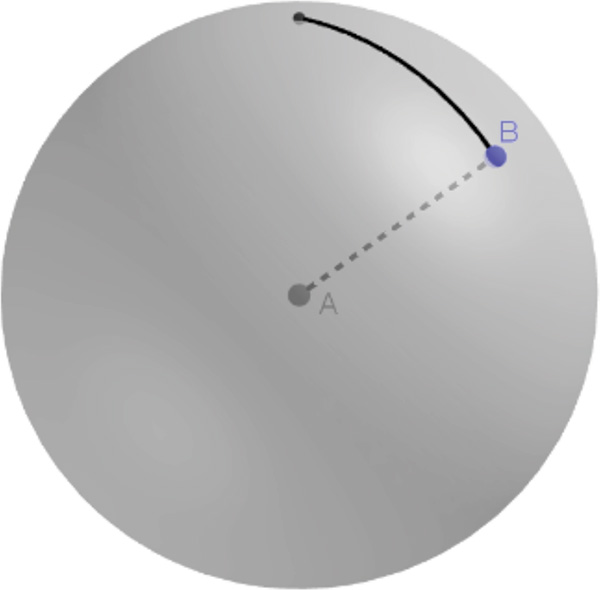
Consider now a second strut CD, pinned at its own base Point C. If the placement of Points A and C are such that there is an intersection between the two spheres, as shown in Figure 2a, a circular mechanism or degree of freedom remains for the node at the apex of the two struts as shown in Figure 2b. Notice that the designer controls the lengths of strut AB and strut CD. These are the radii of the spheres surrounding base Point A and Point C. Yet a two-member structural form is not stable, as the circular degree of freedom or mechanism still exists at the False Crown, and it must be locked down. This False Crown is an unstable point due to the circular mechanism formed by the two pin-ended struts.
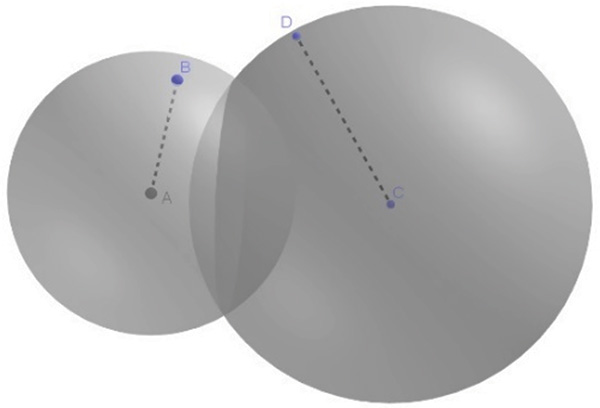
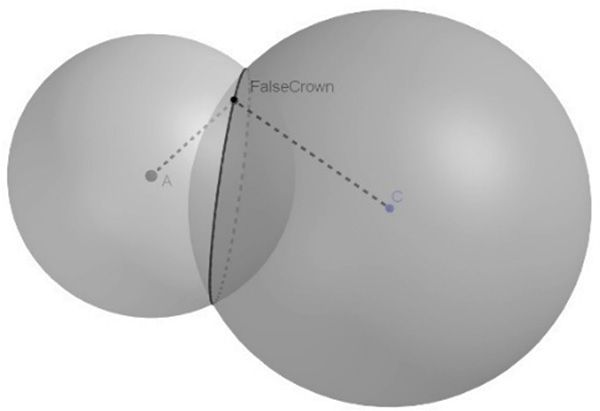
However, the intersection of three spheres, as in Figure 3a, or the intersection of one sphere and one circle, as in Figure 3b, is a unique “Final Crown.” There are two such Final Crowns, one above the ground plane and one below. We choose to focus on the Final Crown above the base, and we use that to create an unconditionally stable tripod. New struts can be built off the stable elevated Crown.
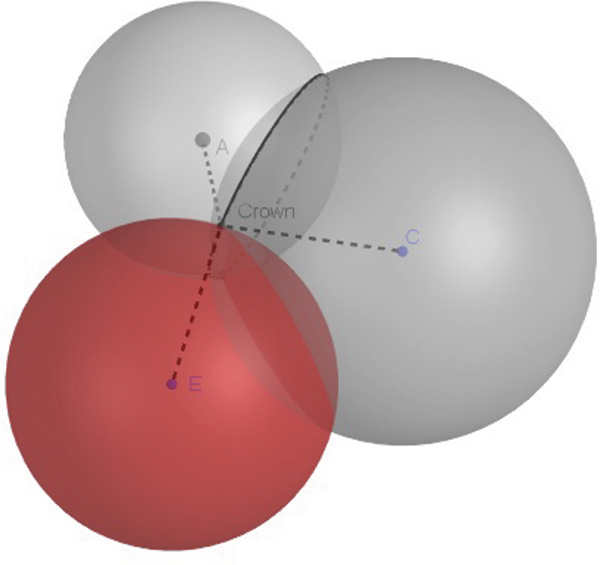
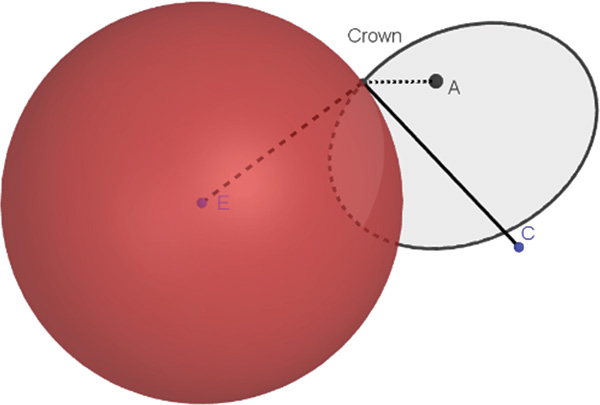
A new design workflow has been created, wherein points in 3D space are linked through this parametric algorithm. While there is nothing special about the initial arrangement of points in 3D space, through a series of steps guided by a mentor, even inexperienced designers generate many ideas quickly. Mentoring of form-finding includes the use of symmetry, or starting with a simple, planar polygon on the base, the use of spheres with matching radii on the corners of the polygon can be a nimble starting point, and as previously stated, circles, which are the intersections of the spheres, are the key tools. It is the intersection of these circles that generates the arrangement of points in 3D. The designer ensures that the structure is stable and statically determinate before making any major changes to the parameters of the polygon or the spheres on the corners of the base polygon. Many delightful forms can be created instantly using this technique. The forms are unconditionally stable if new spheres are created from pinned points on the base plane or unconditionally stable points, such as a previously found stable Crown point, elevated at some height off of the base. Figure 4 shows such sequential stacking of elements.
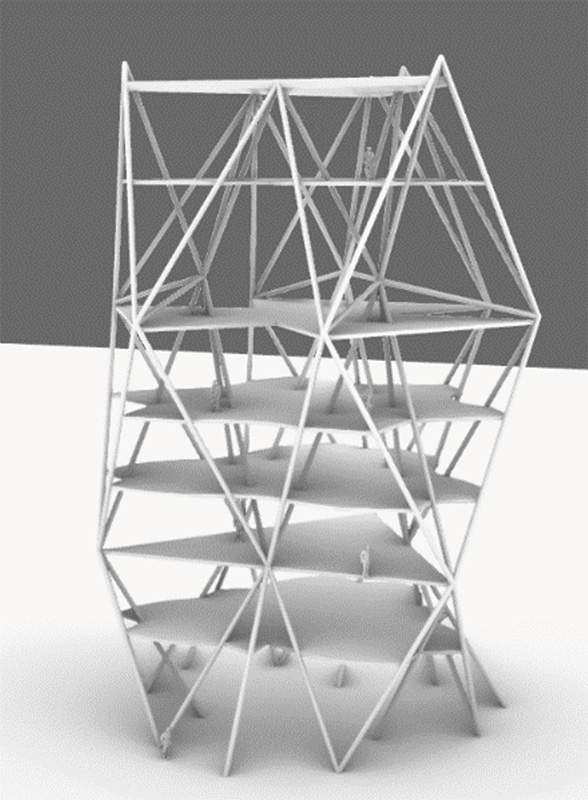
Many techniques have been recently tested at California Polytechnic State University in design studios and in General Education classes for non-engineers. One such technique uses symmetry and a regularly assigned pattern of radii to the spheres being used, as shown in Figure 5a. This rapidly generates a series of intersecting circles, shown in Figure 5b. The intersection of the circles is the starting point of playful yet disciplined form-finding, as shown in Figure 5c.
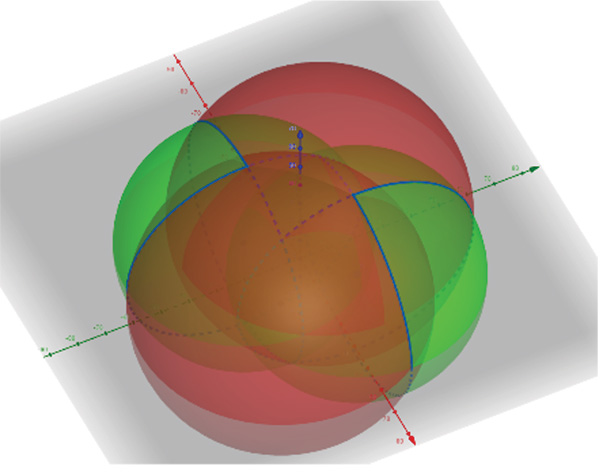
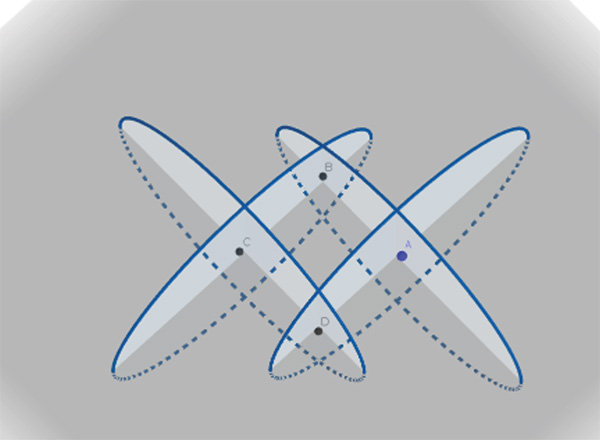
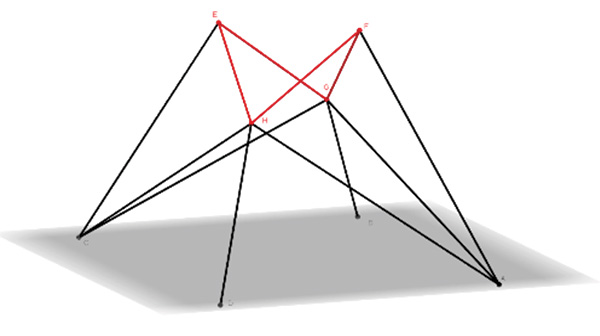
The Double-Skin System
This pedagogy and research is part of a larger endeavor to link “form-finding” to “form testing” to “form making.” Curvilinear shell structures are an ideal vehicle for such explorations as they are economical and can be made of the ultimate renewable material, timber. These pedagogical and research studies allowed Professor Saliklis and Nathan Lundberg to form Poly Shells LLC—a conceptual design company specializing in an innovative timber double-skin thin shell system. This eco-friendly construction method utilizes precisely cut plywood polygons, resulting in lightweight yet remarkably stiff structures. Vertical couplers separate the top and bottom layers of the double-skin. A polygon cap is placed above the top layer, and another cap is placed below the bottom layer. The entire double-skin timber shell can be formed into hyperbolic paraboloid cladding surfaces between the struts of a space frame, or the double-skin can be a standalone funicular shell. The double-skin timber shell is rapidly assembled by hand without the need for screws, clamps, glue, or brackets. The ethos of this workflow embodies the union of high-tech design thinking with low-tech construction methods. Figure 6 shows the double-skin system, while Figure 7 is an example of what can be built in several hours by hand using the double-skin system as a standalone shell.
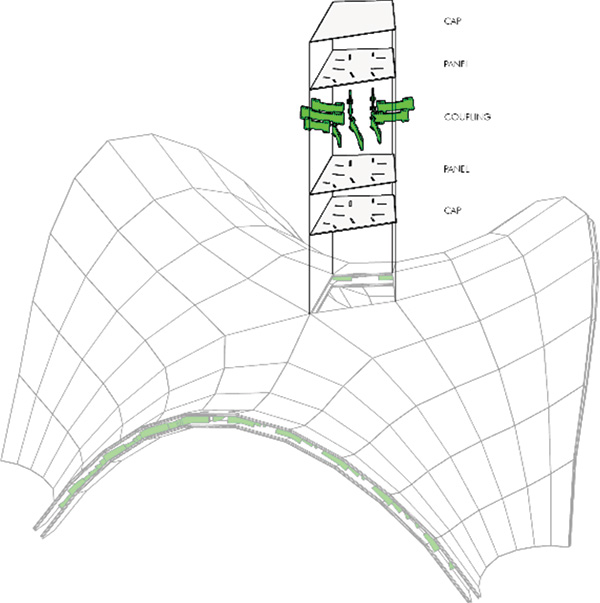
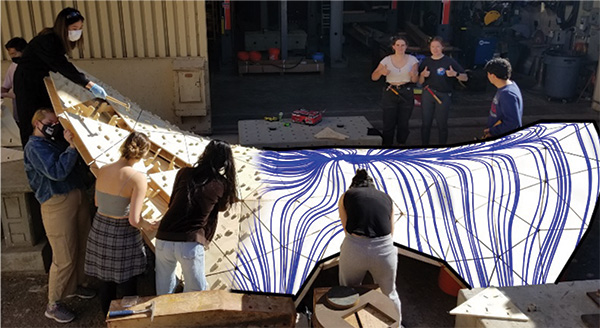
The caps covering the panel on the top layer of the shell are shown in Figure 8 in an exploded view, while Figure 9 shows another rapidly assembled free-standing double-skin Poly Shell.
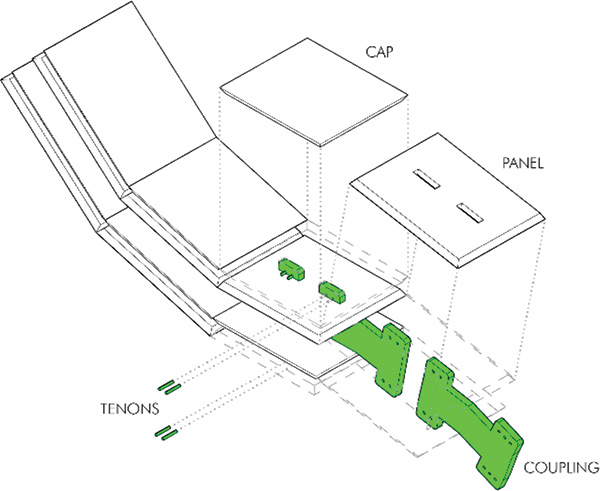
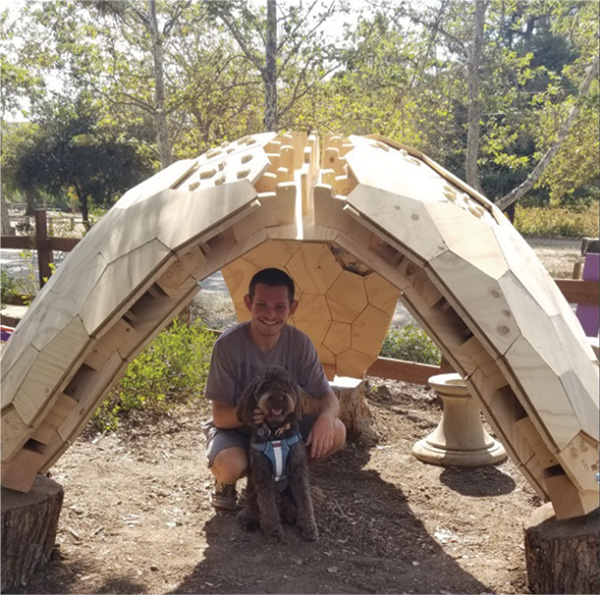
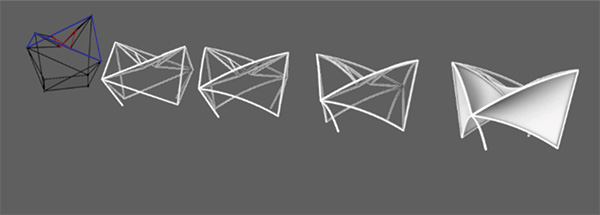
The form-finding of spatial structures can present some insights into the design thinking of past brilliance like that of the engineer/architect Enrico Castiglioni or the architect/professor Anne Ting. This new design methodology of spatial structures is rapid, rigorous, surprising, and infinitely variable, something that Ting and Castiglioni would immediately recognize as both structurally rational and meticulously beautiful. Figure 4 is, in fact, a re-creation of Anne Ting’s unbuilt City Tower design for Philadelphia. This new design approach has been successfully applied in various studio environments and seminars, allowing for the creation of efficient, economical, and elegant forms. The new hybrid structural typology, fusing the space truss with hyperbolic shells, will be known as the Xena Form. The Xena Form was so-named as an homage to Xenakis, but this new structural typology finds echoes in Castiglioni’s and Ting’s precedent-setting forms. The Xena Form is a minimal structure insofar as it is a statically determinate spatial structure, with straight or curved struts forming the structural skeleton. The evolution of an Xena Form with curved struts is shown in Figure 10. Poly Shells’ double-skin cladding is formed in hyperbolic paraboloid areas. The struts bound these hyperbolic paraboloids, and some struts can float above or below the shell surfaces as the designer chooses. In 1958, Xenakis cloaked his rather heavy Philips Pavilion with concrete cladding panels, whereas our new Xena Forms are lean and green, light and stiff. Poly Shells LLC has received industry input from experts in timber construction including LEVER Architecture, NOUS Engineering, PCL Construction and Woden Fire Consultants to explore the potential for realizing the first prototype structure at a University-owned site. The site-specific application will be studied further in 2024. Figures 11a, 11b, and 11c show three different Xena Forms as sunscreens in an arboretum. The forms in Figures 11a and 11b have struts floating above the hyperbolic paraboloid double-skin shells. Still, the form in Figure 11c is a twisted Möbius Strip, which is an abstract mathematical construction, wherein the inner surface is twisted to become the outer surface over the length of the strip. In our Xena Forms, the structural struts bound the hyperbolic paraboloid shell, which acts primarily as cladding. All three forms use lodgepole pine struts.
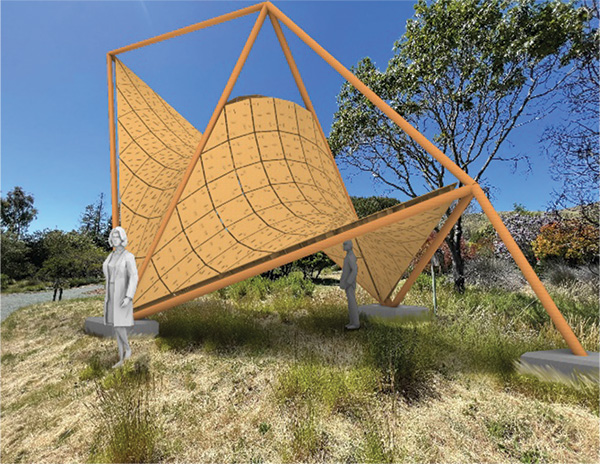
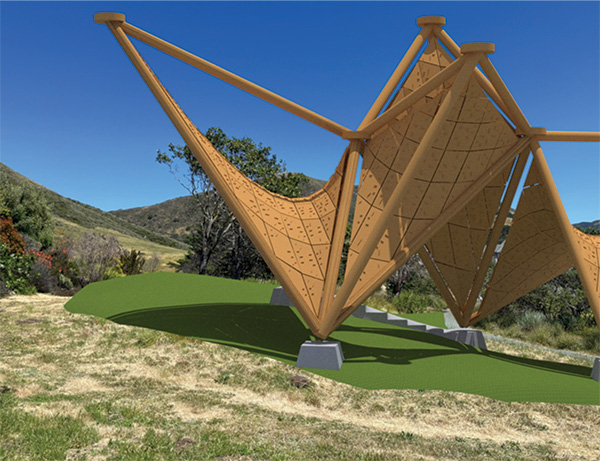
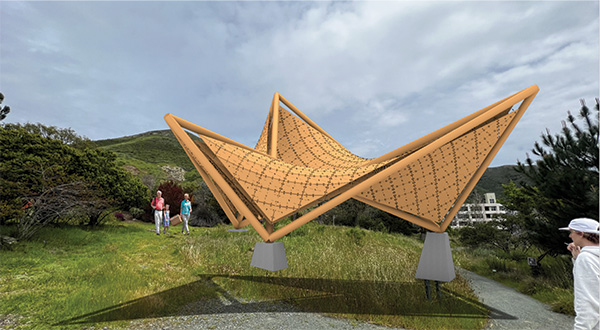
By embracing this new approach, we have the opportunity to redefine the role of the engineer, reigniting the creative spirit within our profession and shaping a future where innovative and elegant structures abound. Through the convergence of playfulness and discipline, we can chart a path toward a more vibrant and impactful structural engineering practice. The collaboration between academia and industry, exemplified by our partnerships with leading design and construction firms, can bridge the gap between theory and practice, ensuring that students are equipped with the skills and knowledge necessary to navigate the complexities of modern structural engineering. With the incorporation of innovative techniques like the double-skin thin shell system, structural engineering undergraduate programs can expose students to cutting-edge technologies that are reshaping the field.
The transformation of structural engineering education requires a shift in mindset—an acknowledgment that structural engineers have the potential to be form finders and to shape the built environment in innovative and aesthetically pleasing ways. By embracing a more open-ended and imaginative pedagogy, structural engineering educators can empower students to become form finders themselves, capable of creating efficient, economical, and elegant structures that push the boundaries of what is possible. This evolution in education will contribute to a renaissance in our profession, unlocking the creative potential of structural engineers and fostering collaborations that lead to groundbreaking designs.
By embracing creativity within the constraints of codes, regulations, mathematics, and physics, fostering interdisciplinary collaborations, and integrating emerging technologies, structural engineers can unleash their artistic and innovative potential, reshaping the future of form-finding and leaving a lasting impact on the built environment. The structural engineer’s role as a form finder will be revitalized, ensuring that the discipline continues to thrive as a powerful force in the 21st century. This new empowerment is a re-claiming of a centuries-old idea that the technically trained engineer can control the forces in a structure by manipulating its form.■
